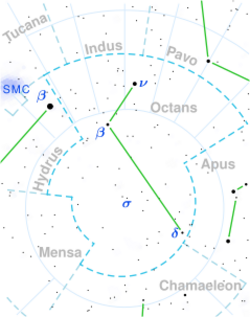Astronomy:Zeta Octantis
| Observation data Epoch J2000.0 Equinox (celestial coordinates) | |
|---|---|
| Constellation | Octans |
| Right ascension | 08h 56m 40.97572s[1] |
| Declination | −85° 39′ 47.3476″[1] |
| Apparent magnitude (V) | 5.42±0.01[2] |
| Characteristics | |
| Spectral type | A8/9 IV[3] or F0 III[4] |
| U−B color index | +0.07[5] |
| B−V color index | +0.31[5] |
| Astrometry | |
| Radial velocity (Rv) | −3.6±2[6] km/s |
| Proper motion (μ) | RA: −117.699[1] mas/yr Dec.: +33.964[1] mas/yr |
| Parallax (π) | 20.9964 ± 0.0776[1] mas |
| Distance | 155.3 ± 0.6 ly (47.6 ± 0.2 pc) |
| Absolute magnitude (MV) | +1.95[7] |
| Details | |
| Mass | 2.06±0.40[8] M☉ |
| Radius | 2.25±0.11[9] R☉ |
| Luminosity | 12.63±0.09[1] L☉ |
| Surface gravity (log g) | 4.04±0.28[8] cgs |
| Temperature | 7,063±325[10] K |
| Metallicity [Fe/H] | −0.36[11] dex |
| Rotational velocity (v sin i) | 115[12] km/s |
| Age | 1.25[13] Gyr |
| Other designations | |
| Database references | |
| SIMBAD | data |
Zeta Octantis, Latinized from ζ Octantis, is a solitary,[15] yellowish-white hued star located in the southern circumpolar constellation Octans. It has an apparent magnitude of 5.42,[2] making it faintly visible to the naked eye under ideal conditions. The star is located relatively close at a distance of only 156 light-years based on Gaia DR3 parallax measurements,[1] but is drifting closer with a radial velocity of −3.6 km/s.[6] At its current distance, Zeta Octantis' brightness is diminished by 0.25 magnitudes due to interstellar dust.[16]
This s an evolved A-type star with a stellar classification of A8/9 IV.[3] David S. Evans and colleagues, however, give it a classification of F0 III,[4] which suggests it is already an evolved giant star. It has double the Sun's mass,[8] and 2.25 times the Sun's radius.[9] It radiates around 13 times the luminosity of the Sun[1] from its photosphere at an effective temperature of 7,063 K.[10] Zeta Octantis is estimated to be 1.25 billion years olds based on stellar evolution models by Trevor J. David and Lynne A. Hillenbrand.[13] It has a low metallicity, having only 44% the abundance of heavy metals compared to the Sun.[11] Despite its advanced age, the object spins rapidly with a projected rotational velocity of 115 km/s,[12] resulting in an oblate shape with a equatorial bulge 11% larger than the polar radius.[17]
References
- ↑ 1.0 1.1 1.2 1.3 1.4 1.5 1.6 Vallenari, A. et al. (2022). "Gaia Data Release 3. Summary of the content and survey properties". Astronomy & Astrophysics. doi:10.1051/0004-6361/202243940 Gaia DR3 record for this source at VizieR.
- ↑ 2.0 2.1 Høg, E.; Fabricius, C.; Makarov, V. V.; Urban, S.; Corbin, T.; Wycoff, G.; Bastian, U.; Schwekendiek, P. et al. (March 2000). "The Tycho-2 catalogue of the 2.5 million brightest stars". Astronomy and Astrophysics 355: L27–L30. ISSN 0004-6361. Bibcode: 2000A&A...355L..27H.
- ↑ 3.0 3.1 Houk, N.; Cowley, A. P. (1975). University of Michigan Catalogue of two-dimensional spectral types for the HD stars. Volume I. Declinations −90° to −53°. Bibcode: 1975mcts.book.....H.
- ↑ 4.0 4.1 Evans, D. S.; Menzies, A.; Stoy, R. H. (1 December 1959). "Fundamental Data for Southern Stars (Second List)". Monthly Notices of the Royal Astronomical Society 119 (6): 638–647. doi:10.1093/mnras/119.6.638. ISSN 0035-8711. Bibcode: 1959MNRAS.119..638E.
- ↑ 5.0 5.1 Mallama, A. (December 2014). "Sloan Magnitudes for the Brightest Stars". Journal of the American Association of Variable Star Observers (JAAVSO) 42 (2): 443. ISSN 0271-9053. Bibcode: 2014JAVSO..42..443M.
- ↑ 6.0 6.1 Evans, D. S. (1967). "The Revision of the General Catalogue of Radial Velocities". Determination of Radial Velocities and Their Applications 30: 57. Bibcode: 1967IAUS...30...57E.
- ↑ Anderson, E.; Francis, Ch. (May 2012). "XHIP: An extended hipparcos compilation". Astronomy Letters 38 (5): 331–346. doi:10.1134/S1063773712050015. ISSN 1063-7737. Bibcode: 2012AstL...38..331A.
- ↑ 8.0 8.1 8.2 Stassun, Keivan G.; Oelkers, Ryan J.; Pepper, Joshua et al. (20 August 2018). "The TESS Input Catalog and Candidate Target List". The Astronomical Journal 156 (3): 102. doi:10.3847/1538-3881/aad050. Bibcode: 2018AJ....156..102S.
- ↑ 9.0 9.1 Kervella, P.; Thévenin, F.; Di Folco, E.; Ségransan, D. (October 2004). "The angular sizes of dwarf stars and subgiants". Astronomy & Astrophysics 426 (1): 297–307. doi:10.1051/0004-6361:20035930. ISSN 0004-6361. Bibcode: 2004A&A...426..297K.
- ↑ 10.0 10.1 Bai, Yu; Liu, JiFeng; Bai, ZhongRui; Wang, Song; Fan, DongWei (2 August 2019). "Machine-learning Regression of Stellar Effective Temperatures in the Second Gaia Data Release". The Astronomical Journal 158 (2): 93. doi:10.3847/1538-3881/ab3048. Bibcode: 2019AJ....158...93B.
- ↑ 11.0 11.1 Netopil, Martin (4 May 2017). "Metallicity calibrations for dwarf stars and giants in the Geneva photometric system". Monthly Notices of the Royal Astronomical Society 469 (3): 3042–3055. doi:10.1093/mnras/stx1077. ISSN 0035-8711. Bibcode: 2017MNRAS.469.3042N.
- ↑ 12.0 12.1 Huang, Su-Shu (September 1953). "A Statistical Study of the Rotation of the Stars.". The Astrophysical Journal 118: 285. doi:10.1086/145751. ISSN 0004-637X. Bibcode: 1953ApJ...118..285H.
- ↑ 13.0 13.1 David, Trevor J.; Hillenbrand, Lynne A. (12 May 2015). "The Ages of Early-type Stars: Strömgren Photometric Methods Calibrated, Validated, Tested, and Applied to Hosts and Prospective Hosts of Directly Imaged Exoplanets". The Astrophysical Journal 804 (2): 146. doi:10.1088/0004-637X/804/2/146. Bibcode: 2015ApJ...804..146D.
- ↑ "Zeta Octantis". SIMBAD. Centre de données astronomiques de Strasbourg. http://simbad.u-strasbg.fr/simbad/sim-basic?Ident=Zeta+Octantis.
- ↑ Eggleton, P. P.; Tokovinin, A. A. (11 September 2008). "A catalogue of multiplicity among bright stellar systems". Monthly Notices of the Royal Astronomical Society 389 (2): 869–879. doi:10.1111/j.1365-2966.2008.13596.x. ISSN 0035-8711. Bibcode: 2008MNRAS.389..869E.
- ↑ Gontcharov, George A.; Mosenkov, Aleksandr V. (28 September 2017). "Verifying reddening and extinction for Gaia DR1 TGAS main sequence stars". Monthly Notices of the Royal Astronomical Society 472 (4): 3805–3820. doi:10.1093/mnras/stx2219. ISSN 0035-8711. Bibcode: 2017MNRAS.472.3805G.
- ↑ van Belle, Gerard T. (14 March 2012). "Interferometric observations of rapidly rotating stars". The Astronomy and Astrophysics Review 20 (1): 51. doi:10.1007/s00159-012-0051-2. ISSN 0935-4956. Bibcode: 2012A&ARv..20...51V.
<ref> tag with name "Gould1879" defined in <references> is not used in prior text.
 |


